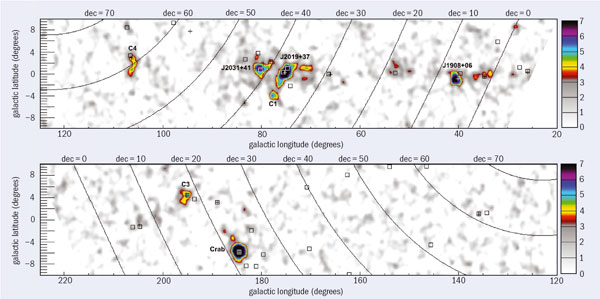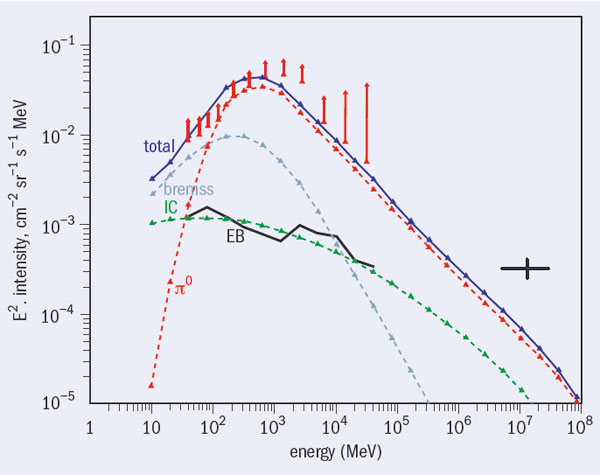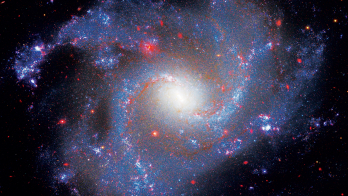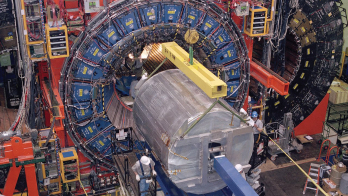Impressive results from this extensive air shower detector in New Mexico.
Milagro – Spanish for miracle – was the first of a new generation of extensive air shower (EAS) detectors. Traditionally, EAS arrays have been composed of a discrete set of small detectors, spread over large areas. Typically active over approximately 1% of the enclosed area only, they were sensitive to cosmic gamma rays with energies of around 100 TeV and above. The combination of steeply falling source spectra and the absorption in flight of these high-energy gamma rays via interactions with the cosmic microwave background radiation meant that this first generation of instruments did not succeed in detecting any astrophysical sources. In contrast, imaging atmospheric Cherenkov telescopes (IACT), pioneered by Trevor Weekes at Mount Hopkins, led to the discovery of several tera-electron-volt gamma-ray sources, the first of which was the Crab Nebula, the remnant of a supernova that occurred in 1054 (Weekes et al. 1989). More recently an array of such detectors, the HESS telescopes in Namibia, have demonstrated the richness of the tera-electron-volt sky.

Image credit: Aurore Simonnet, Sonoma State University.
Despite these difficulties, the advantages of EAS arrays, with their large instantaneous field of view (around 2 sr) and continuous operation, provided strong motivation to improve the technique. The key to success was to lower the energy threshold and simultaneously improve the ability to reject the abundant cosmic-ray background. Water Cherenkov technology, developed for underground proton-decay physics experiments such as the Irvine Michigan Brookhaven and Kamiokande detectors, led the way to this success.
When employed above ground as an EAS array, water Cherenkov technology enables the construction of an array that is sensitive over its entire area. The Cherenkov angle in water is 41° so an array of photomultiplier tubes (PMTs) placed at a depth comparable to their spacing can detect the Cherenkov light emitted from any electromagnetic particle entering the water volume. Moreover, the composition of an EAS at ground level is predominantly photons (which are around six times as numerous as electrons and positrons), and, as the depth of water above the PMTs is sufficient to convert these gamma rays to charged particles, these photons can also be detected by the PMTs.
The Milagro detector is located in the Jemez Mountains of northern New Mexico. It is operated by the Los Alamos National Laboratory in partnership with the National Science Foundation and the US Department of Energy Office of Science. Milagro uses a covered water reservoir that contains 2.5 × 107 litres of water and measures 80 m × 60 m, with a depth of 8 m. The reservoir is instrumented with 750 PMTs deployed in two layers. The top layer of 450 PMTs is beneath 1.5 m of water with a spacing of 2.8 m. This layer is used to reconstruct the direction of the primary gamma ray or cosmic ray by measuring the relative arrival time of the shower front to around 0.5 ns. The second layer of PMTs, beneath 6 m of water, is used to detect the penetrating component of any EAS initiated by hadronic cosmic rays. An array of 175 water tanks surrounds the central water reservoir. Each is 1 m high and 3 m in diameter and is lined with reflective Tyvek. A single 8 inch PMT mounted at the top of each tank looks down into the water volume.

Image credit: Ulisse Bravar.
After seven years of operation, four of which included the array of outrigger water tanks, Milagro ceased operation in April this year. Its results have been impressive and ushered in a new era for ground-based gamma-ray astrophysics at tera-electron-volt energies, where the role of the EAS arrays is now clearly established.
The figure above shows a region around the galactic plane as observed by Milagro, where the median energy of the detected gamma rays is 20 TeV (Abdo et al. 2007b). It contains several noteworthy features. The sources marked JXXXX+YY, where XXXX and YY are the right ascension and declination, respectively, are three new sources that Milagro discovered. MGRO J2031+41 and MGRO J2019+37 lie within the Cygnus region of the galaxy. This direction points into our spiral arm and is rich with possible cosmic-ray acceleration sites, such as Wolf–Rayet stars, OB associations (a sign of star formation) and supernova remnants. The locations of these two sources are coincident with sources of giga-electron-volt gamma rays discovered by the Energetic Gamma Ray Emission Telescope (EGRET) on NASA’s Compton Gamma Ray Observatory (the squares mark the locations of gamma-ray sources of more than 100 MeV reported in the 3rd EGRET catalogue). However, the true nature of the sources is still to be determined.
The third new source shown in the figure above is MGRO J1908+06. This was subsequently observed by HESS, which measured a “hard” energy spectrum, falling more or less with the square of the energy. Preliminary analysis of Milagro data indicates that this source may be emitting gamma rays with energies in excess of 100 TeV, which would make it the highest-energy gamma-ray source detected to date and a likely site of cosmic-ray acceleration.
In addition to these three sources, there are four other regions in Milagro’s view of the galaxy that are likely to be sources of tera-electron-volt gamma rays. The image above shows three of these regions: C1, C3 and C4. C2, which is not indicated, lies just above C1.
The source candidate C4 is coincident with the Boomerang pulsar wind nebula, and the shape seen in tera-electron-volt gamma rays is similar to that observed at 100 MeV. C3 is coincident with the Geminga pulsar (although no pulsed emission is observed at tera-electron-volt energies), which, at a distance of 180 pc, is the closest pulsar to the Earth and the brightest source of giga-electron-volt gamma rays visible in the northern sky. Finally, C1 has no giga-electron-volt source in the vicinity and its nature is at present completely unknown. The air shower array operating at Yangbajing cosmic-ray observatory in Tibet has confirmed this source, in addition to the two others that lie in the Cygnus region. One interesting feature of these is that they appear to be extended, with diameters ranging from 0.25° to more than 1°. Large sources are difficult for IACTs to detect, possibly explaining why they have eluded detection until now, despite the fact that these regions had been examined by past IACT arrays, such as the Whipple Observatory and the High Energy Gamma Ray Astronomy experiment.

The second image also shows a diffuse glow visible around the galactic plane, especially in the Cygnus region and at lower galactic longitude. This arises from the interaction of hadronic cosmic rays and high-energy cosmic-ray electrons with matter and radiation in the galaxy. The interaction of cosmic-ray protons with matter leads to the production of neutral pions that subsequently decay into gamma rays. The high-energy electrons interact with low-energy (optical, infrared and cosmic microwave background) photons through Compton scattering to produce high-energy gamma rays. Prior to Milagro’s measurements, EGRET observed this galactic diffuse radiation up to about 30 GeV and discovered an excess of diffuse emission over predictions based on the known matter density in the galaxy and the cosmic-ray rate and spectrum measured at the Earth. The explanation for this excess is still a matter of debate, with possible solutions including the annihilation of dark matter. A much greater intensity of high-energy electrons throughout the galaxy than is measured at the Earth, and a miscalibration of the EGRET response at high energies, are also possible explanations.

The third image shows Milagro’s measurement of the diffuse emission at 12 TeV in the Cygnus region (Abdo et al. 2007a). This measurement indicates that at tera-electron-volt energies the excess over expectations is even larger than it is at giga-electron-volt energies. While the cause of this excess is a matter of debate, possible explanations include cosmic-ray acceleration sites in the region, unresolved sources of tera-electron-volt gamma rays in the region, and the presence of very-high-energy electrons in the region. The resolution of this puzzle will require more detailed observations. Whatever the final explanation, it is clear that gamma-ray astronomy is an important tool in answering the nearly century-old problem of the origin of cosmic radiation.

Image credit: Alex Carrillo.
While observations with Milagro have drawn to a close, plans for a new instrument are proceeding. A joint US–Mexico collaboration has proposed the High Altitude Water Cherenkov (HAWC) telescope to be located at Volcà n Sierra Negra (Tliltepetl) near the site of the Large Millimeter Telescope in Mexico. At 4100 m above sea level (compared with 2600 m above sea level for Milagro) and with a dense sampling detector that encloses around 22,000 m2, HAWC is expected to be about 15 times as sensitive as Milagro and have an energy threshold of less than 1 TeV. Unlike Milagro, it will comprise 900 individual water tanks. Each tank will be 5 m in diameter and 4.6 m tall – much larger than those used by Milagro or the Pierre Auger Observatory in Argentina – and would have a PMT at the bottom looking up into the water volume. If built, the complete array will have an unprecedented level of sensitivity to the highest-energy particle accelerators in our galaxy, as well as the sensitivity needed to detect short flares from active galaxies and the ability to make a detailed map of the diffuse gamma-ray emission in our galaxy.





